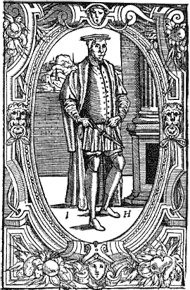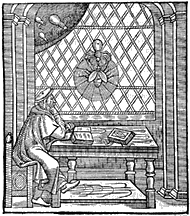|
|
|
|



JOHN HEYWOOD, English dramatist and epigrammatist, is generally said to have been a native of North Mimms, near St. Albans, Hertfordshire, though Bale says he was born in London. A letter from a John Heywood, who may fairly be identified with him, is dated from Malines in 1575, when he called himself an old man of seventy-eight, which would fix his birth in 1497. He was a chorister of the Chapel Royal, and is said to have been educated at Broadgates Hall (Pembroke College), Oxford. From 1521 onwards his name appears in the king's accounts as the recipient of an annuity of ten marks as player of the virginals, and in 1538 he received forty shillings for "playing an interlude with his children" before the Princess Mary.
 He is said to have owed his introduction to her to Sir Thomas More, at whose seat at Gobions near St. Albans he wrote his epigrams, according to Henry Peacham. More took a keen interest in the drama, and is represented by tradition as stepping on to the stage to take an impromptu part in the dialogue. William Rastell, the printer of four of Heywood's plays, was the son of More's brother-in-law, John Rastell, who organized dramatic representations, and possibly wrote plays himself. Mr. A.W. Pollard sees in Heywood's firm adherence to Catholicism and his free satire of legal and social abuses a reflection of the idea of More and his friends, which counts for much in his dramatic development. He is said to have owed his introduction to her to Sir Thomas More, at whose seat at Gobions near St. Albans he wrote his epigrams, according to Henry Peacham. More took a keen interest in the drama, and is represented by tradition as stepping on to the stage to take an impromptu part in the dialogue. William Rastell, the printer of four of Heywood's plays, was the son of More's brother-in-law, John Rastell, who organized dramatic representations, and possibly wrote plays himself. Mr. A.W. Pollard sees in Heywood's firm adherence to Catholicism and his free satire of legal and social abuses a reflection of the idea of More and his friends, which counts for much in his dramatic development.
His skill in music and his inexhaustible wit made him a favorite both with Henry VIII and Mary. Under Edward VI, he was accused of denying the king's supremacy over the church, and had to make a public recantation in 1554; but with the accession of Mary his prospects brightened. He made a Latin speech to her in St. Paul's Churchyard at her coronation, and wrote a poem to celebrate her marriage. Shortly before her death she granted him the lease of a manor and lands in Yorkshire. When Elizabeth succeeded to the throne he fled to Malines, and is said to have returned in 1577. In 1587 he is spoken of as "dead and gone" in Thomas Newton's epilogue to his works.
John Heywood is important in the history of English drama as the first writer to turn the abstract characters of the morality plays into real persons. His interludes link the morality plays to the modern drama, and were very popular in their day. They represent ludicrous indicents of a homely kind in the style of the broadest farce, and approximate to the French dramatic renderings of the subjects of the fabliaux. The fun in them still survives in spite of the long arguments between characters and what one of their editors calls his "humour of filth." Heywood's name was actually attached to four interludes. The Play called the foure PP; a newe and a very mery interlude of a palmer, a pardoner, a potycary, a pedler (not dated) is a contest in lying, easily won by Palmer, who said he had never known a woman out of patience. The Play of the Wether, a new and mery interlude of all maner of Wethers (printed 1533) describes the chaotic results of Jupiter's attempts to suit the weather to the desires of a number of different people. The Play of Love (printed 1533) is an extreme instance of the author's love of wire-drawn argument. It is a double dispute between "Loving not Loved" and "Loved not Loving" as to which is the more wretched, and between "Both Loved and Loving" and "Neither Loving nor Loved" to decide which is the happier. The only action in this piece is indicated by the stage direction marking the entrance of "Neither loved nor loving," who is to run about the audience with a huge copper tank on his head full of lighted squibs, and is to cry "Water, water! Fire, fire!" The Dialogue of Wit and Folly is more of an academic dispute than a play.
But two pieces universally assigned to Heywood, although they were printed by Rastell without any author's name, combine action with dialogue, and are much more dramatic. In The Mery Play between the Pardoner and the Frere, the Curate and Neybour Pratte (printed 1533, but probably written much earlier) the Pardoner and the Friar both try to preach at the same time, and, coming at last to blows, are separated by the other two personages of the piece. The Mery Play betwene Johan Johan the Husbande, Tyb the Wyfe, and Syr Jhan the Preest (printed 1533) is the best constructed of all his pieces. Tyb and Syr Jhan eat the "Pye" which is the central "property" of the piece, while Johan Johan is made to chafe wax at the fire to stop a hole in a pail. This incident occurs in a French Farce nouvelle très bonne at fort joyeuse de Pernet qui va au vin. Heywood has sometimes been credited with the authorship of the dialogue of Gentylnes and Nobylyte printed by Rastell without date, and Mr. Pollard adduces some ground for attributing to him the anonymous New Enterlude called Thersytes (played 1538).
 Heywood's other works are a collection of proverbs and epigrams, the earliest extant edition of which is dated 1562; some ballads, one of them being the "Willow Garland," known to Desdemona; and a long verse allegory of over 7000 lines entitled The Spider and the Flie (1556). A contemporary writer in Holinshed's Chronicle said that neither its author nor any one else could "reach unto the meaning thereof." But the flies are generally taken to represent the Roman Catholics and the spiders the Protestants, while Queen Mary is represented by the housemaid who with her broom (the sword) executes the commands of her master (Christ) and her mistress (the church). Dr. A.W. Ward speaks of its "general lucidity and relative variety of treatment." Heywood says that he laid it aside for twenty years before he finished it, and, whatever may be the final interpretation put upon it, it contains a very energetic statement of the social evils of the time, and especially of the deficiencies of English law.
Heywood's other works are a collection of proverbs and epigrams, the earliest extant edition of which is dated 1562; some ballads, one of them being the "Willow Garland," known to Desdemona; and a long verse allegory of over 7000 lines entitled The Spider and the Flie (1556). A contemporary writer in Holinshed's Chronicle said that neither its author nor any one else could "reach unto the meaning thereof." But the flies are generally taken to represent the Roman Catholics and the spiders the Protestants, while Queen Mary is represented by the housemaid who with her broom (the sword) executes the commands of her master (Christ) and her mistress (the church). Dr. A.W. Ward speaks of its "general lucidity and relative variety of treatment." Heywood says that he laid it aside for twenty years before he finished it, and, whatever may be the final interpretation put upon it, it contains a very energetic statement of the social evils of the time, and especially of the deficiencies of English law.
Excerpted from:
Encyclopedia Britannica, 11th Ed., vol. XIII.
Cambridge: Cambridge University Press, 1910. 438-9.
Images:
Top, Woodcut portrait of John Heywood from "Spider and the flie" (1556), Folger Shakespeare Library.
Center, Woodcut from "Spider and the flie" (1556), Folger Shakespeare Library.
Bottom, Woodcut from "Spider and the flie" (1556), Folger Shakespeare Library.
 | to John Heywood |
Site copyright ©1996-2018 Anniina Jokinen. All Rights Reserved.
Created by Anniina Jokinen on July 10, 2006. Last updated December 16, 2018.
|
|
The Tudors
King Henry VII
Elizabeth of York
King Henry VIII
Queen Catherine of Aragon
Queen Anne Boleyn
Queen Jane Seymour
Queen Anne of Cleves
Queen Catherine Howard
Queen Katherine Parr
King Edward VI
Lady Jane Grey
Queen Mary I
Queen Elizabeth I
Renaissance English Writers
Bishop John Fisher
William Tyndale
Sir Thomas More
John Heywood
Thomas Sackville
John Bale
Nicholas Udall
John Skelton
Sir Thomas Wyatt
Henry Howard
Hugh Latimer
Thomas Cranmer
Roger Ascham
Sir Thomas Hoby
John Foxe
George Gascoigne
John Lyly
Thomas Nashe
Sir Philip Sidney
Edmund Spenser
Richard Hooker
Robert Southwell
Robert Greene
George Peele
Thomas Kyd
Edward de Vere
Christopher Marlowe
Anthony Munday
Sir Walter Ralegh
Thomas Hariot
Thomas Campion
Mary Sidney Herbert
Sir John Davies
Samuel Daniel
Michael Drayton
Fulke Greville
Emilia Lanyer
William Shakespeare
Persons of Interest
Visit Encyclopedia
Historical Events
Field of the Cloth of Gold, 1520
Pilgrimage of Grace, 1536
The Babington Plot, 1586
The Spanish Armada, 1588
Elizabethan Theatre
See section
English Renaissance Drama
Images of London:
London in the time of Henry VII. MS. Roy. 16 F. ii.
London, 1510, the earliest view in print
Map of England from Saxton's Descriptio Angliae, 1579
Location Map of Elizabethan London
Plan of the Bankside, Southwark, in Shakespeare's time
Detail of Norden's Map of the Bankside, 1593
Bull and Bear Baiting Rings from the Agas Map (1569-1590, pub. 1631)
Sketch of the Swan Theatre, c. 1596
Westminster in the Seventeenth Century, by Hollar
Visscher's Panoramic View of London, 1616. COLOR
|
|